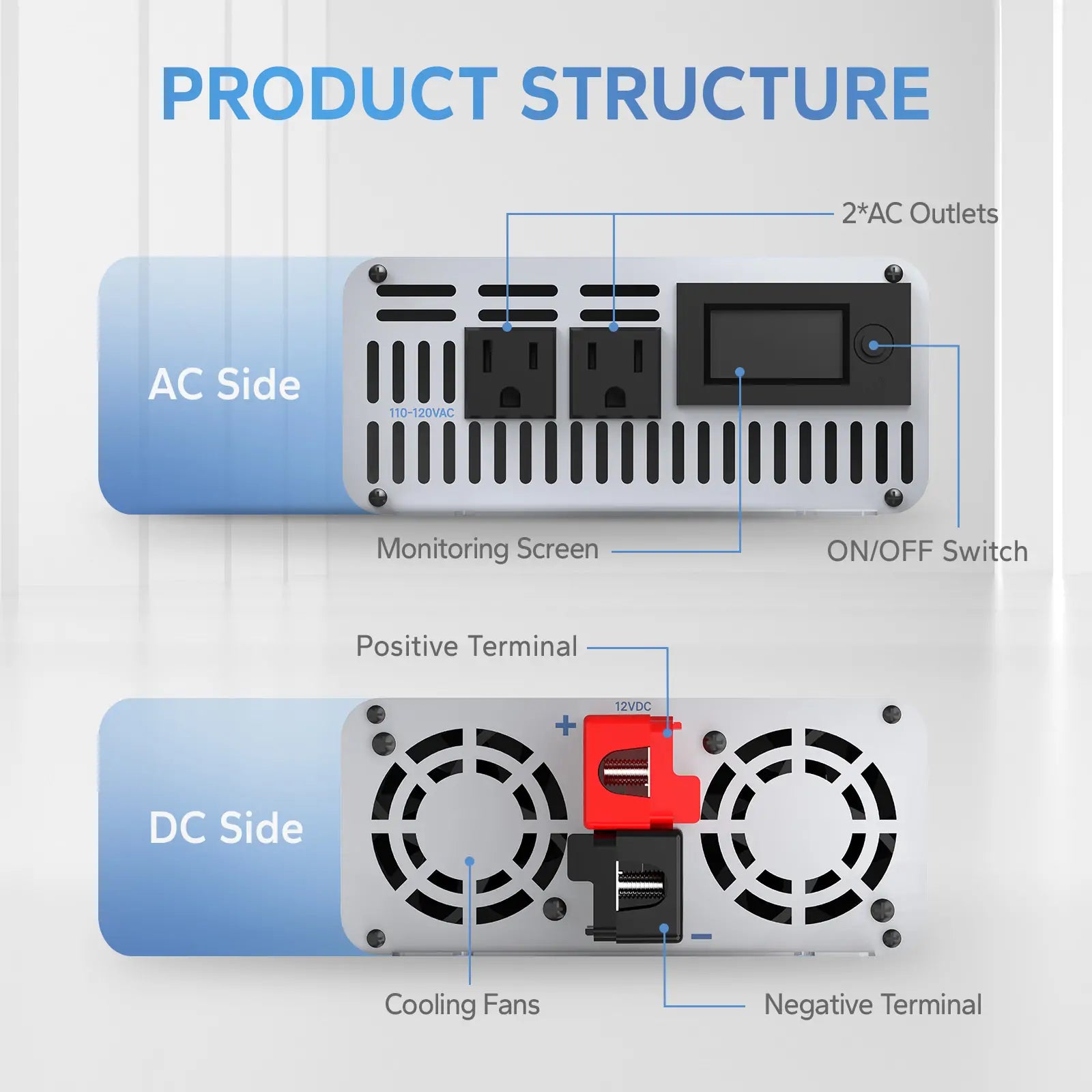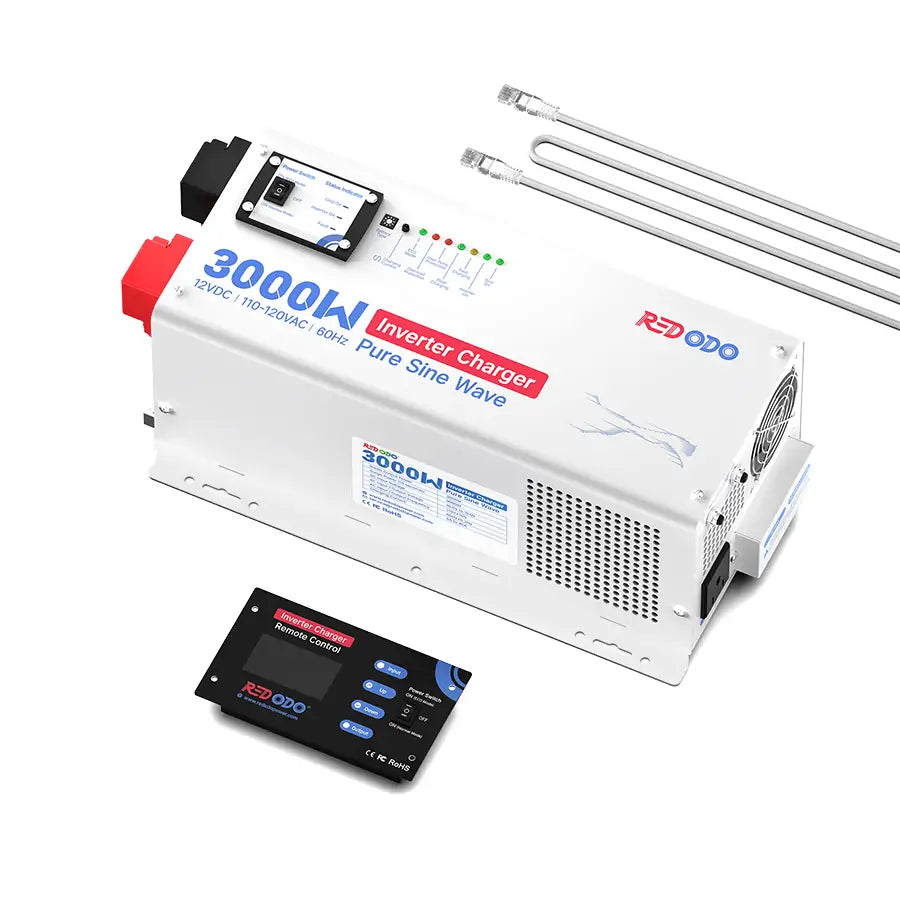Battery inverters play a crucial role as the intermediary between the photovoltaic system and the devices that consume energy from the system. Their function is to convert the direct current (DC) output generated by solar panels into the alternating current (AC) format, which is the standard used by all commercial appliances.

In this article, we will have a full guide of pure sine wave inverter, let’s dive in.
Table of Content
- Part 1: Pure Sine Wave Inverter vs. Modified Wave Inverter
- 1.1 What is Pure Since Wave Inverter
- 1.2 What is Modify Since Wave Inverter
- 1.3 Pure Sine Wave VS Modified Wave Inverter
- 1.4 What Can I Run with a Modified Sine Wave Inverter?
- Part 2: What Size Inverter Do I Need?
- Part 3: How To Connect Pure Sine Wave Inverter to Your Battery
- FAQS about Inverter
Part 1: Pure Sine Wave Inverter vs. Modified Wave Inverter
1.1 What is Pure Since Wave Inverter
A pure sine wave inverter generates voltage in the form of a sine wave, which is also the output provided by the utility grid. Therefore, if you are connecting your system to the grid, a pure sine wave inverter is always necessary. It is particularly recommended for sensitive appliances, newer TVs, CFL light bulbs, and appliances equipped with AC motors such as microwaves and refrigerators.
Pure sine wave inverters deliver cleaner, smoother, and more reliable power, ensuring uninterrupted operation of appliances and electronics. They also produce less noise during operation. At Redodo, we offer a variety of pure sine wave inverters with different capacities to accommodate your solar installation and energy requirements.
1.2 What is Modified Wave Inverter
Comparing a pure sine wave inverter and a modified sine wave inverter, the former produces a smooth and seamless alternating current that closely resembles a true sine wave. In contrast, the latter abruptly switches polarity, resulting in a choppy waveform with a stepped square pattern. This jagged waveform can negatively affect sensitive equipment, making it unsafe to operate medical equipment like CPAP machines. Moreover, devices connected to a modified sine wave inverter may produce a humming sound.
In terms of safety, operational efficiency, and compatibility, a pure sine wave inverter is far superior to a square wave.
1.3 Pure Sine Wave VS Modified Wave Inverter
The main differences between a pure sine wave inverter and a modified sine wave inverter are efficiency and cost. Pure sine wave inverters are efficient in powering devices that require AC power and they provide clean power to sensitive devices that are susceptible to interference, such as radios. However, they are usually more expensive. On the other hand, modified sine wave inverters are less expensive but may introduce interference, resulting in a less pure current.

To determine the appropriate type of inverter for your needs, consider the following questions:
- Does the device you intend to power utilize a motor?
- Is your device a precision medical device?
- Does the device you want to power use a rectifier?
- Can your device be powered using a DC adapter?
If you answered yes to either of the first two questions, a pure sine wave inverter is likely the suitable choice for you.
1.4 What Can I Run with a Modified Sine Wave Inverter?
Modified sine wave inverters are appropriate for basic systems that do not involve sensitive electronics. If you don't have any appliances with AC motors or delicate medical equipment, a modified sine wave inverter may be sufficient. Generally, older tube TVs, water pumps, and phone chargers can function adequately with a modified sine wave inverter.
However, appliances like refrigerators, microwaves, and devices with AC motors will not operate as efficiently when powered by a modified sine wave inverter. Certain fluorescent lights may also appear dimmer or emit buzzing or humming sounds when connected to such inverters.

Part 2: What Size Inverter Do I Need?
When choosing a solar inverter, it's important to consider its size and wattage rating. Solar inverters convert the DC electricity produced by solar panels into AC electricity for use in your home or building.
Ideally, the capacity of your inverter should closely match the power output of your solar panel system. For instance, if you have a 2000-watt system, it's recommended to select a 2000 watt inverter. By aligning the sizes, you can ensure efficient conversion of electricity and maximize the performance of your solar energy system.
Take note of the voltage of your battery as well. The DC voltage rating on the inverter will indicate which battery bank it is compatible with. For instance, a 12V battery bank would require an inverter that supports a 12V DC input.
Efficiency is another important consideration when selecting an inverter. Inverters have an efficiency rating that indicates how effectively they convert DC power from the battery to AC power. A higher efficiency rating means less power loss during the conversion process. Opting for a more efficient inverter can help conserve energy and maximize power output. Redodo's high-quality battery inverter like the 3000w pure sine wave inverter has the efficiency up to 90%.
When deciding on an inverter, it is important to consider its peak power capability. Certain devices, particularly those with motors or compressors, may require a higher amount of power during startup or when experiencing power surges. To avoid overloading or damaging the equipment, it is crucial to ensure that the inverter can handle these peak power demands.
Choosing an inverter with some headroom is generally recommended. Opting for a slightly larger inverter than the calculated total power consumption allows for flexibility in accommodating future needs or unexpected power surges.
If you are uncertain about the appropriate size of the inverter for your specific requirements, it is advisable to consult the manufacturer or seek advice from an expert in the field. They can provide personalized guidance based on your power needs and assist you in selecting an inverter that suits your requirements.
Part 3: How To Connect Pure Sine Wave Inverter to Your Battery
Take Redodo 2000W Pure Sine Wave inverter for example.
Avoid direct contact between the terminals of positive and negative wires connected to the battery, and do not reverse the positive and negative connections.
Step 1: Connect the included wires to the battery terminals.

Step 2: Make sure the intverter is in the OFF status. Considering the safety, this step is really important.

Step 3: Remove the insulating caps on the terminals, and unscrew the metal hexagon nuts with flange from the bolts.

Step 4: Attach the wire lugs and metal hexagon nuts with flange to the bolts in the following sequence: Wire Lug → Metal Hexagon Nut with Flange.
Use a torque wrench to tighten the nuts to the bolts under the 12N·m to 14N·m setting to connect the wires to the inverter, positive to positive; negative to negative.

Step 5: Put on the insulating caps.

Step 6: Turn ON the inverter power, the monitoring screen will light up assuming proper battery connection, and the inverter is now ready for use.

Connecting to Devices
Make sure the inverter is in the OFF position before connecting loads (electronic devices) to the AC outlets.
Avoid switching on the inverter with the load already turned on. This may trigger an overload since some electronic devices have an initial high power surege to start.
Be sure to turn off all loads first before switching off the inverter. Even if the inverter is turned off, the capcacitors will still have a charge, so the DC and AC terminals must be disconnected if altering the circuitry.

So Which Type Should I Choose?
In the past, pure sine wave inverters were often considered a pricier choice for consumers. However, with the decreasing cost of pure sine wave inverters, they have become more affordable and accessible. While modified sine wave inverters remain a viable option for powering limited and basic appliances, they may not offer the same level of efficiency. If you value the assurance of your appliances and devices running safely and at optimal efficiency, we recommend investing in a pure sine wave inverter.
FAQs about Inverter
1. What type of inverter is most efficient?
High-quality sine wave inverters like Redodo typically have an efficiency rating of 90-95%. In contrast, lower-quality modified sine wave inverters tend to be less efficient, with ratings ranging from 75-85%. Additionally, high-frequency inverters generally exhibit higher efficiency compared to low-frequency ones. It's important to note that the efficiency of an inverter can vary depending on the load it is powering.
2. What are the advantages of using a pure sine wave inverter?
Pure sine wave inverters offer several advantages:
- They provide clean and stable power, making them compatible with a wide range of sensitive electronics and appliances.
- They ensure efficient operation and prolong the lifespan of devices.
- They eliminate electrical interference, reducing the risk of malfunctions or damage to connected equipment.
- They can power a broader range of appliances, including those with AC motors and devices that utilize transformers or chargers.
3. What types of devices or appliances require a pure sine wave inverter?
Devices and appliances that typically require a pure sine wave inverter include:
- Sensitive electronics like laptops, computers, and smartphones
- Medical equipment such as CPAP machines and oxygen concentrators
- Audio and video equipment, including TVs, home theater systems, and gaming consoles
- Refrigerators, microwaves, and other appliances with AC motors
- Tools and machinery with variable speed drives
Conclusion
In conclusion, inverter plays a crucial role in solar system. It is important to carefully consider the type of inverter to use, as it can greatly impact the performance and safety of your electrical devices. Pure sine wave inverters provide a smooth and clean power output, making them the preferred choice for powering sensitive equipment such as medical devices, laptops, and audiovisual systems.
By understanding the differences between pure sine wave and modified sine wave inverters, you can make informed choices that will ensure the longevity, efficiency, and safety of your electrical equipment.

Redodo

Redodo
Recent Post

A Full Review of Redodo 12V 100Ah Battery Series

Are 2 100Ah Lithium Batteries Better Than 1 200Ah Lithium Battery?

Group 24 vs. Group 27 Marine Batteries: Which One is Right for You?

Group 27 vs. Group 31 Battery: Key Differences & How to Choose






![⚡[$183 after Sign-Up] Redodo 12V 100Ah Group 24 Bluetooth LiFePO4 Battery | Real-Time Battery Monitoring | For RV, Marine, Solar](http://www.redodopower.com/cdn/shop/files/12v_100ah_group24_bt.jpg?v=1740479299)
![⚡[$183 after Sign-Up] Redodo 12V 100Ah Group 31 Bluetooth Lithium Battery | Real-Time Battery Monitoring | For RV, Marine, Solar](http://www.redodopower.com/cdn/shop/files/group31_bt_8b15b24d-d0f8-4605-bfa9-766b727debc4.jpg?v=1740397479)
![⚡[$238 after Sign-Up] Redodo 12V 140Ah Group 31 Lithium Battery with Bluetooth | 40% More Capacity | For RV, Marine, Solar Home](http://www.redodopower.com/cdn/shop/files/140ah_rv_f737f25f-aac4-4d2c-ae25-d2a93710ddc2.jpg?v=1740397307)



![⚡[$539.99 Limited Offer] Redodo 12V 300Ah Lithium LiFePO4 Battery | Replaces 6*12V 100Ah AGM Batteries | RV, Marine, Solar](http://www.redodopower.com/cdn/shop/files/12V_300.png?v=1738929525)